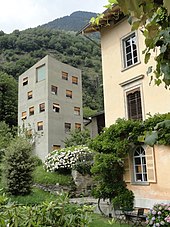Silvia Andrea
Silvia Andrea , actually Johanna Garbald-Gredig (* March 20 or March 22, 1840 in Zuoz , Upper Engadin , † March 4, 1935 in Castasegna , Bergell ), was a Swiss writer.
Life
Johanna Gredig, born in Romansh , attended the village school in Zuoz. She learned the basics of the German language there and from her father, Thomas Gredig, a teacher, although her father was also particularly concerned with maintaining the Romansh language . Later she attended a German girls' school in Chur , where she immersed herself enthusiastically in German literature . In 1861 she married the scientifically interested toll collector Agostino Garbald (1828–1909) and moved to Castasegna in Bergell.
During the first 16 years of the childless marriage, which from the outset was thought to be unconventional and emancipated, Johanna Garbald-Gredig was able to devote herself to her further training and writing. Andrea was born in 1877, Margherita in 1880 and Augusto in 1881. Many of her works date from this early period, but later, as a mother of three, she was still active as a writer. Despite her native Romansh language, she always wrote in German under the name Silvia Andrea . Her works (some of which have been translated into Romansh and Italian) include a prose version of "Wilhelm Tell" (1891) expanded to include female characters, novels, short stories and poems. She was acquainted with Joseph Victor Widmann and was promoted by him.
The Villa Garbald in Castasegna, commissioned by the Garbald couple , was designed by the architect Gottfried Semper and is his only building south of the Alps. Semper never saw the villa personally. Today, with a modern extension, it serves as a conference and seminar center for ETH Zurich .
Works (selection)
- Faustine. Novel. Vogel, Glarus 1889.
- William Tell. Historical story, dedicated to the Swiss people for the national celebration. Frauenfeld 1891.
- The Bergell. Walks in the landscape and its history. Huber, Frauenfeld 1901.
- The Rhaetian; An apostle. Two stories from Graubünden's past. W. Schäfer, Schkeuditz 1905.
- Violanta Prevosti. Historical novel. Huber, Frauenfeld 1905.
- We and our darlings. Huber, Frauenfeld 1914.
- The Rüfe. A story. Huber, Frauenfeld 1927.
literature
- Andrea, Silvia . In: Gisela Brinker-Gabler , Karola Ludwig, Angela Wöffen (eds.): Lexicon of German-speaking women writers 1800–1945 . Deutscher Taschenbuch Verlag, Munich 1986, ISBN 3-423-03282-0 , p. 12.
- Garbald-Gredig, Mrs. Johanna . In: Sophie Pataky (Hrsg.): Lexicon of German women of the pen . Volume 1. Verlag Carl Pataky, Berlin 1898, p. 243 ( digitized version ).
- Andrea, Silvia . In: Sophie Pataky (Hrsg.): Lexicon of German women of the pen . Volume 1. Verlag Carl Pataky, Berlin 1898, p. 12 ( digitized version ).
- Silvia, Andrea . In: Sophie Pataky (Hrsg.): Lexicon of German women of the pen . Volume 2. Verlag Carl Pataky, Berlin 1898, p. 307 ( digitized version ).
- Maya Widmer: Andrea, Silvia. In: Historical Lexicon of Switzerland .
Individual evidence
- ↑ March 20th according to HLS , March 22nd according to Lexicon of German Women in Spring 1898 and Swiss Writer's Lexicon 1918.
- ↑ a b c Garbald-Gredig, Mrs. Johanna . In: Sophie Pataky (Hrsg.): Lexicon of German women of the pen . Volume 1. Verlag Carl Pataky, Berlin 1898, p. 243 ( digitized version ).
- ↑ Article Garbald-Gredig, Johanna in: Hermann Aellen (Ed.): Swiss Writer Lexicon , Ed. 1918. Swiss Heimatkunst-Verlag, Weinfelden 1918.
- ↑ a b Maya Widmer: Silvia Andrea. In: Historical Lexicon of Switzerland . December 9, 2010 , accessed April 27, 2020 .
- ↑ Ilma Rakusa: Lighthouse and Thinking Laboratory - 150 years ago Gottfried Semper built the Villa Garbald in Castasegna. Today it is a cultural center in Bergell. In: Neue Zürcher Zeitung . No. 97 . Zurich April 28, 2014, p. 33 .
- ↑ Gisela Brinker-Gabler, Karola Ludwig, Angela Wöffen: Lexicon of German-speaking women writers 1800-1945. dtv Munich, 1986. ISBN 3-423-03282-0 . P. 12
- ↑ garbald.ch: The project ( Memento of the original from August 1, 2008 in the Internet Archive ) Info: The archive link was inserted automatically and has not yet been checked. Please check the original and archive link according to the instructions and then remove this notice. , accessed October 13, 2008
Web links
- Publications by and about Silvia Andrea in the Helveticat catalog of the Swiss National Library
| personal data | |
|---|---|
| SURNAME | Andrea, Silvia |
| ALTERNATIVE NAMES | Garbald-Gredig, Johanna (real name); Gredig, Johanna (maiden name) |
| BRIEF DESCRIPTION | Swiss writer |
| DATE OF BIRTH | March 20, 1840 or March 22, 1840 |
| PLACE OF BIRTH | Zuoz |
| DATE OF DEATH | March 4, 1935 |
| Place of death | Castasegna |
